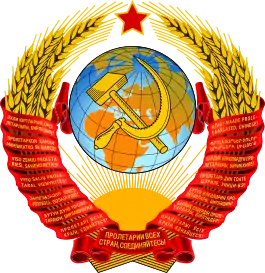Flag of the Estonian Soviet Socialist Republic
The flag of the Estonian Soviet Socialist Republic flag shows a yellow hammer and sickle and outlined star on a red field above a band of water waves near the bottom,[1] and was adopted by the Estonian SSR on February 6, 1953.
.svg.png.webp) Flag of the Estonian SSR (1953–1990) | |
| Use | Historical |
|---|---|
| Proportion | 1:2 |
| Adopted | 6 February 1953 |
| Design | A red flag with the golden hammer and sickle and outlined star above a band of blue water waves near the bottom. |
.svg.png.webp) Reverse Flag | |
| Use | Historical |
| Proportion | 1:2 |
.svg.png.webp) Flag of the Estonian SSR (1940–1953) | |
| Use | Historical |
| Proportion | 1:2 |
| Adopted | 27 July 1940 |
The description of the flag is described from the Supreme Soviet of the Estonian SSR:
"Eesti Nõukogude Sotsialistliku Vabariigi riigilipp koosneb punase taustaga lipust, mille kaudu sinine laineline triip koos kahe valge triibuga peal, moodustades piki lipu pikkust kuus turris lainet. Sinine laineline triip, mille valged triibud on kolm kümnendikku (3/10) lipu laiusest. Ülemine punane riba on pool lipu laiusest, alumine punane triip - viiendik (1/5) lipu laiusest lipu punase osa ülaosas vasakus ülanurgas, ühe kaugusel. - kuuendik lipu pikkusest lipumastist, kujutab kuldvasarat ja sirpi ning nende kohal on viiekordne punane täht, mida raamib kuldne ääris. Lipu laiuse ja pikkuse suhe on 1: 2'
English Translation:
"The national flag of the Estonian Soviet Socialist Republic consists of the flag with the red background, through which the blue wavy stripe with two white stripes on top, forming along the length of the flag six spiky waves. Blue wavy stripe with white stripes of three-tenths (3/10) of the flag's width. The top red bar is half the width of the flag, the lower red stripe - one-fifth (1/5) of the flag's width at the top of the red part of the flag in the upper left corner, at a distance of one-sixth of the flag's length from the flagpole, depicts a gold hammer and sickle and above them is a five-pointed red star framed by a gold border. The ratio of the flag's width to its length is 1:2 "[2]
History
From 1940, the flag was red with a gold hammer and sickle in the top-left corner. Above the hammer and sickle were the gold Latin characters ENSV (Eesti Nõukogude Sotsialistlik Vabariik) in a sans-serif font. The flag was restored again in 1944 after the re-capture of Estonia from Nazi Germany.
On February 6, 1953, the final version of the Estonian SSR flag was adopted. Though similar to the flag of the Soviet Union, it has the six spiky blue wavy stripes with the white stripe on the bottom. Neither the Constitution (Fundamental Law) of the Estonian SSR, nor in the statute of the national flag of the Estonian SSR mentioned the shade of blue wavy stripes on the flag. Soviet vexillologist V. N. Streltsov in Odessa described it as "electric blue".[2]
During that period, many of the Estonian diaspora continued to use the blue-black-white flag including the government in-exile over the years during occupation.
The Soviet flag of Estonia was gradually discarded during the perestroika period between 1988 and 1989. Beginning in 1990, the flag was reverted to the tricolor flag used in 1918, which remained as the flag after the restoration of independence only a year later. This was defined on May 10, 1990 when the Presidium of the Supreme Soviet of the Republic of Estonia adopted a resolution "On the use of the national flag as a national symbol of the restoration of independence of the Republic of Estonia" (Eesti rahvuslipu kui taastatava iseseisva vabariigi riikliku sümboli kasutamise korra kohta), which regulated the use of the tricolor flag.[2]
See also
- Flag of the Soviet Union
- Coat of arms of the Estonian SSR
- Flag of Magadan Oblast, similar design
- Flag of Estonia
- Flag of the Latvian Soviet Socialist Republic — a visually similar flag
Notes
- Guide to the Flags of the World by Mauro Talocci, revised and updated by Whitney Smith (ISBN 0-688-01141-1), p. 20.
- Эстонская ССР
